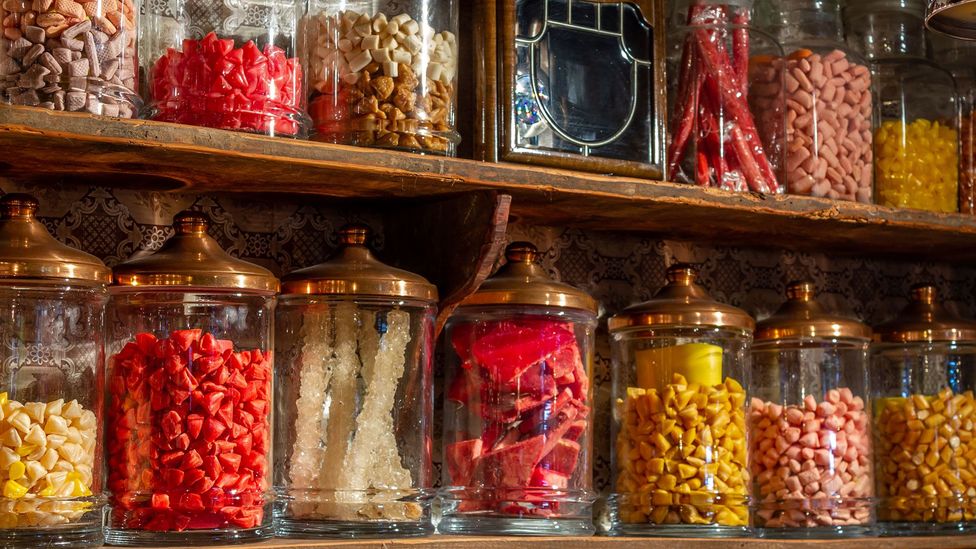
On 8 September 1941, Nazi forces surrounded Leningrad from the west and south, and through Finland to the north. A thin strip of land across Lake Ladoga kept the residents in touch with the rest of Russia, but heavy shelling made it impossible to evacuate the population. This was the beginning of the Siege of Leningrad, the costliest in terms of lives lost in history.
As the population starved, it was not unheard of for people to murder for ration cards and eat corpses. While the number of cannibalism cases were very few in proportion to the size of the population, the widespread fear of cannibals led to hysteria. The police even threatened unruly citizens with imprisonment in cannibals’ cells to maintain order. In many cases, corpse-eaters were often the most desperate people in society and largely involved single, unemployed mothers. Most of those caught for cannibalism were pitied and imprisoned rather than shot.
Despite people’s desperate condition, there was one source of food that remained untouched if you knew where to look. The Institute of Plant Industry’s gene bank in Leningrad was and remains the largest collection of seeds in the world: the most comprehensive catalogue of plants’ genetic information we have. Should any of the archived plant species become extinct in the outside world, these seeds, grains and tubers could be used to reintroduce them.
Even in their emaciated condition, the botanists at the institute defended the stores with their lives. They feared desperate people would storm the gene bank and eat their way through their life’s work, or invading forces would destroy the building to prevent its contents being used.
When the Red Army of the Soviet Union finally managed to lift the siege on 18 January 1943, almost two and a half years after it began, the seed bank was still intact.
You might also like:
- What happens when we run out of food?
- The bleak, chilling magazine for nuclear doomsday preppers
- The two ways that Western civilisation could collapse
Should humanity face a similar crisis, whether a nuclear apocalypse or worldwide war, which foods might be safe for the survivors to eat, and how long will those foods last? To understand that, we need to ask what makes food go off.

Residents walk through the streets of besieged Leningrad. One pulls the body of a dead relative on a sled (Credit: Getty Images)
“Most foods, not all, spoil for the same reason – because of the growth of microbes,” says Michael Sulu, an expert in food chemistry at University College London, in the UK. Food can be preserved by drying, salting, chilling or storing in air-tight containers. All are attempts to limit microbial growth, and have been used with greater or lesser success for millennia in various forms.
Sulu says that drying is the most effective, followed by salting, while storing in air-tight containers is not enough on its own.
It is almost impossible to completely remove pathogens from food without also destroying the food itself. Instead, preservation techniques focus on limiting the growth of microbes. Drying is effective because in low-water environments microbial growth is inhibited. Microbes need water to pass the food they need into their cells and to push toxins out. Without this ability to transfer things in and out of their cells, microbes cannot multiply. Lower concentrations of water also inhibit oxidation, which is another way that food spoils.
The reason that storing food in air-tight containers is less effective is because there are probably already a lot of microbes on the food before you put it in the container – and some of those microbes are perfectly happy in low-oxygen environments. Some microbes that spoil meat, for example, are anaerobic – meaning they respire without the need for oxygen. “Those microbes are likely to be very bad for you,” says Sulu, “so drying is better than removing air.”
Salting meat is effective because it too removes moisture, creating an environment where microbes cannot survive. A highly salty environment prevents bacterial cells from functioning properly in a process called osmotic shock. “Salt draws liquid and other stuff out of the cells of microbes, disrupting the way ions move across their membranes,” says Sulu.
Sugar coating can create osmotic shock, too. Generally, things that are high in sugar tend to last a long time. In its dried form, refined sugar will not support any microbial growth at all. Toffees, boiled sweets (which are typically 80% sugar in the form of sucrose and glucose) and other hard candies also show little microbial growth and tend to last for years. But once you start adding other ingredients, such as dairy, nuts, starch, gelatin or eggs to confectionery, its lifespan starts to fall. Caramels and chocolates, for example, are prone to yeasts and moulds, while bacteria introduced during manufacture can also slowly breed in these products too.
Perhaps the most famous single example of a long-lasting processed food is the last McDonald’s Big Mac in Iceland. The last Big Mac ever sold, before the fast food chain closed its only restaurant in the country in 2009, is still on display. While wilted and pale, mould has not set in. The owners of the Big Mac are hardly following Sulu’s food-preservation advice to a tee. The burger is kept in a glass box, limiting the amount of air that it is exposed to, but other than that it would appear the only preservatives keeping it mould-free are the ones it was made with.
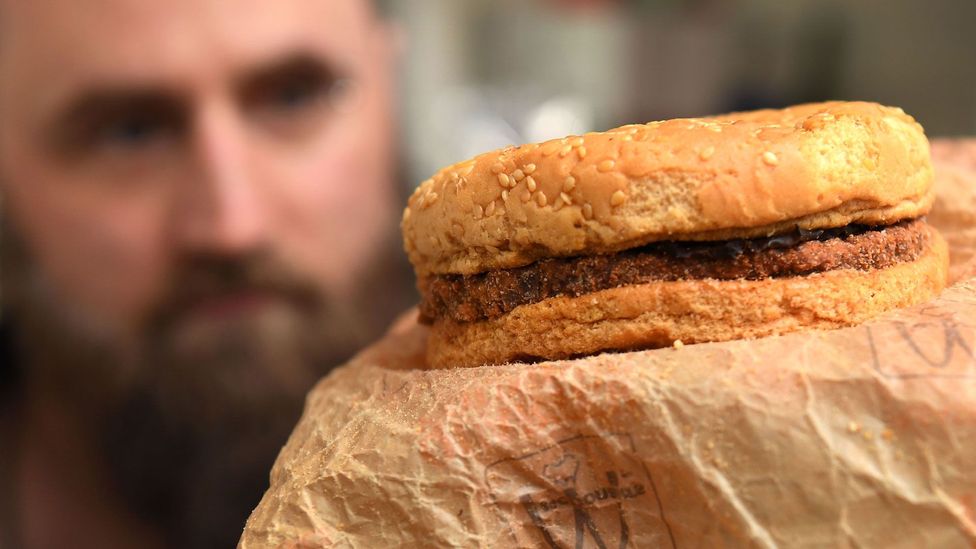
In 2019, an Australian man showed off a Big Mac he claims to have bought in 1995 (Credit: Getty Images)
But in what could be considered a thinly veiled dig at their competitor, Burger King launched an advertising campaign showing one of their burgers wilting and going mouldy to promote the fact they were removing preservatives from their burgers. Although, McDonald’s itself also announced in 2018 that it too was removing a number of preservatives from its burgers, buns and sauces.
Preservatives are used in foods like these to extend their shelf lives in supermarkets or while in storage in kitchens. Retailers want their produce to give a consistent eating experience whether they are bought after one week or four sitting on their shelves. Hence “best before” dates do not refer to when a product might become unsafe to eat, but when it might go soft, stale, change colour or generally fall below an acceptable level of appearance for the manufacturer.
In McDonald’s case, one of the preservatives it ditched in 2018 was calcium propionate, which is used to prevent mould growth on bread, while it also got rid of another mould inhibitor – sorbic acid – from the cheese it uses, and sodium benzoate, which inhibits the growth of bacteria, from its Big Mac special sauce.
Sugary Twinkies are one snack with a particular reputation for long life. With starring roles in a number of Hollywood blockbusters, from Ghostbusters (1984) to Die Hard (1988), perhaps there is no screen appearance that more perfectly encapsulates one of the snack’s best-known myths, that they are apocalypse-proof, than Zombieland (2009). The protagonists spend the entire movie searching high and low for a Twinkie in a post-apocalyptic world but are repeatedly foiled.
A Twinkie is, contrary to its reputation, no longer lasting than similar treats.
People have been asking whether Twinkies are apocalypse-proof long before Zombieland was released. While the ingredients list on the back of a Twinkie does contain a long stream of additives and preservatives, those ingredients are no different to ones found in other highly processed foods. A Twinkie is, contrary to its reputation, no longer lasting than similar treats.
The shelf life of a Twinkie is only a few weeks, but fans of the product have experimented with keeping the snack in bell jars and time capsules for up to 44 years. One video on YouTube shows a 27-year-old Twinkie being opened and cut apart. The snack is rock-solid, and while not particularly mouldy, it is far from edible.
While a sugary Twinkie might last a little longer than other types of sponge cakes, their post-apocalypse credentials pale in comparison to the longest lasting foods.
Honey is almost impossible to spoil because it is high in sugar and low in water, and as a result, preserves very well. Samples of honey that are up to 3,000 years old have been found in tombs of nobility in Georgia and the tomb of Tutankhamun in Egypt.
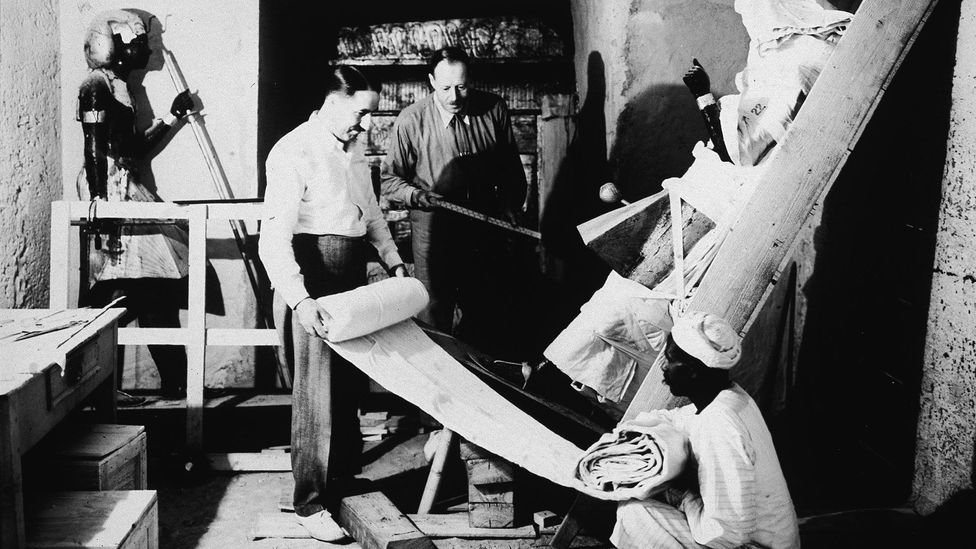
Among the treasures discovered in the tomb of Tutankhamen was a well-preserved jar of honey (Credit: Getty Images)
“Preserving things has been the same for thousands of years,” says Sulu. “The methods that we employ today are largely the same as our ancestors.”
Alcohol and archaeology
Knowing how ancient foods have stood the test of time can provide some clues about which items in our own cupboards are most resilient, and could in the future be unearthed by our descendants.
“Very fat-rich foods can be preserved for a long time,” says Mark Thomas, professor of evolutionary genetics at UCL. “Things like butter and cheese, tallow or oils. Fat excludes water, which means these things preserve well.”
Bog butters, highly fermented butters that have been found buried in peat bogs, that are up to 4,000 years old have been unearthed in Ireland and Scotland. It is thought ancient people buried the butter – or animal fat according to one theory – in the peat to either preserve it or hide it from thieves.
One modern experiment, where butter was buried in a bog for three months, left it tasting “gamey” and a bit like “salami”
And although bog butter has quite a waxy appearance, it is theoretically edible – the acidic, oxygen-free bog water prevents decomposition, which is why trees and even human corpses are found in peat bogs looking surprisingly well preserved. Some people have even tried bog butter – but their description of the “rancid” taste does not make it sound too appealing. One modern experiment, where butter was buried in a bog for three months, left it tasting “gamey” and a bit like “salami” according to those who tried it.
Burying food, however, is a good way for it to survive for long periods of time, provided the conditions are right. Mummies in China have been found adorned with cheese necklaces – probably some sort of kefir. Here it is thought the arid, salty soil helped preserve both the mummies and the cheese. Though the cheese necklaces look quite unappetising, Thomas notes we should perhaps not be so quick to judge.
“I mean, many people would say modern cheese is unpalatable,” he says.
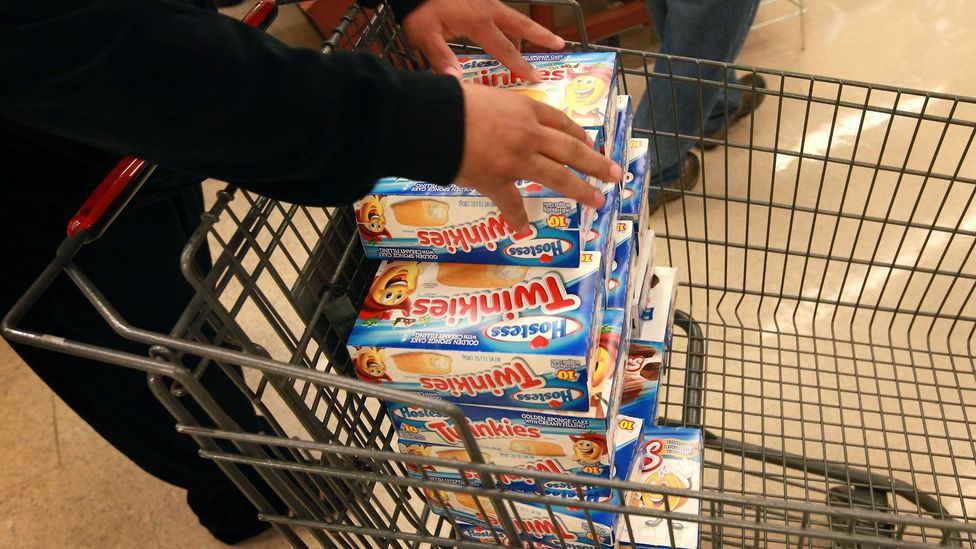
People have been asking whether Twinkies are apocalypse-proof for years (Credit: Getty Images)
The oldest-known bottle of wine, found in an ancient Roman tomb in Speyer, Germany, pushes what is palatable to the limit. The contents of the 1,700-year-old bottle are thick, congealed and discoloured. No one dares open the wine to test its contents.
But, some of the world’s oldest champagne, 200-year-old bottles of Clicquot discovered in a shipwreck on the Baltic seabed, was perfectly palatable when drunk by diver Christian Ekstrom in 2010. He described it as having a “very sweet taste”, and said it was still bubbly. The shipwreck’s location, far below the surface of the sea in frigid, dark waters, helped to protect the wine from degrading.
One of the recovered bottles was eventually sold at auction in 2011 for €30,000 (£26,248). The shipwreck was dated between 1825 and 1830, making these bottles the oldest known drinkable champagne, if not the oldest outright.
But are there any examples of ancient meat standing the test of time? A good place to look might be in the permafrost of the frozen north, or animals trapped inside glaciers.
Ancient frozen flesh can look perfectly edible while still in deep freeze, but it quickly becomes putrid after defrosting
Ancient frozen flesh can look perfectly edible while still in deep freeze, but it quickly becomes putrid after defrosting. Accounts of explorers who have discovered mammoth remains attest to this. One such example, the Berezvoka mammoth, a 40,000-year-old specimen found in Siberia in 1900, had flesh that was dark red and “streaked and marbled with thick layers of fat”, according to Adrian Lister’s book Mammoths.
“It looked so appetising that we wondered for some time whether we should not taste it, but no one would venture to take it into his mouth,” said the expedition leader at the time. “The dogs cleaned up whatever mammoth meat was thrown to them.”
After defrosting, the flesh turned grey and unappetising, but “it seems unlikely that these hardy explorers would not have given it a go,” Lister tells me over email. One scientist is supposed to have eaten a portion, which made him sick. Another account, told to a historian at the KTH Royal Institute for Technology in Stockholm by some palaeontologists who had discovered frozen mammoth meat, describes how it turned to smelly sludge when they tried to fry it.
Flesh greys as it goes off because of a substance called adipocere, which is inedible to humans. Also known as “corpse wax” or “grave wax”, adipocere forms as anaerobic bacteria begin to break down the fats in flesh. Levels of adipocere are used by forensic scientists to determine the age of corpses from the amount of putrefaction. Ice crystals formed during freezing can also damage the muscle fibres in meat.
Certainly, people have been discovering mammoth remains for centuries and there are plenty of apocryphal tales of mammoth feasts across Russia. An account from a Chinese writer around 1700 AD describes a beast “whose Russian name is ‘Momentuow’” and is “as big as an elephant, crawls in tunnels, and dies as it meets the Sun or the Moon light. Its teeth are like an elephant’s, white, soft and smooth with no crackles.”
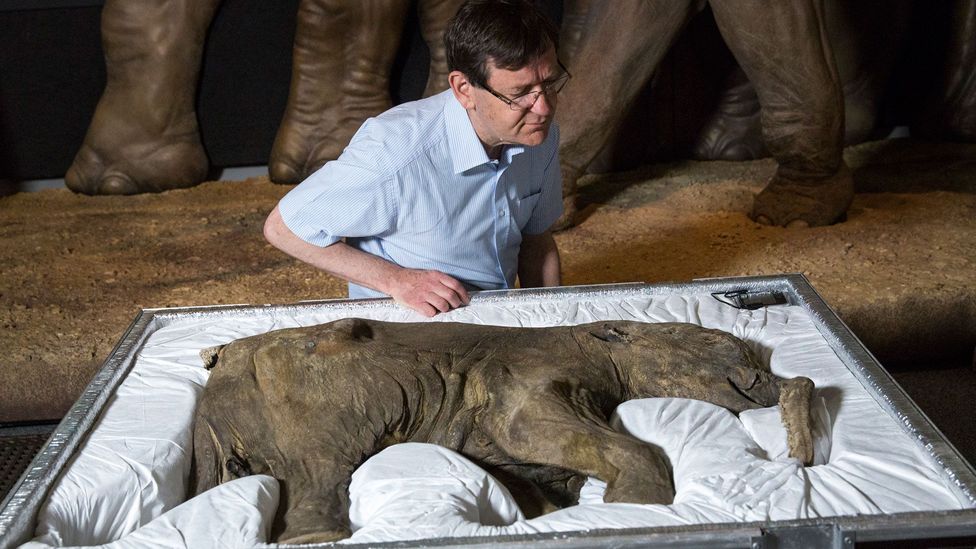
Adrian Lister examines Lyuba, the world’s most complete mammoth, after her arrival at the Natural History Museum, London (Credit: Getty Images)
The writer suggests that the meat is “chilly and cold in character” and can ward off “uneasiness and fever”.
Fish is perhaps even worse at surviving the freezing process. After being frozen for prolonged periods, cod muscle loses most of its water content, becoming tough when thawed and cooked. Fish muscles also undergo a number of chemical changes when frozen for long periods that over time will make it less and less palatable.
Meat by its very nature tends to come laden with all kinds of microorganisms, which makes it unsuitable for long periods of storage. But technology might help to solve that.
“Ten years in the future, cellular agriculture – growing meat rather than growing an animal and cutting it out – could make food safer for longer,” says Sulu, referring to the sorts of lab-grown foods being developed by companies like Impossible Foods. “By definition, they are aseptic.”
Ice age or nuclear apocalypse?
But if civilisation were to suddenly end, the manner in which this happens would determine what we could safely eat. Sulu says that unless something has happened to contaminate the food – such as a nuclear or chemical incident – it would still be possible to walk into a supermarket and be confident of eating anything that is not found in the fresh aisle. So in the event of a natural disaster, or a sudden collapse in the normal food supply chains, tinned or dried foods, and depending on how long they had been there for, frozen foods might be OK.
“I would start off with anything that is vacuum packed or dried as well,” says Sulu. “That way you get the double hit of no air and no moisture.” The speed of dehydration is relatively important, too. Drying slowly allows some bacteria to adapt and form hardy endospores that are able to lie dormant until conditions are more favourable. Some spore-forming bacteria are thermophilic, and so are stable at high temperatures, others are mesophilic, and stable at room temperatures, which means that heat-treatment is not always enough to ensure they have been removed.
This means slow-dried food could still harbour microbes. Spray-dried or freeze-dried foods, like instant coffee grounds and fine powders, are dried much more quickly, and so last longer.
If something were to happen, however, that led to food above ground being left inedible, it may still be possible to find something to eat, if you know where to look.
Buried deep beneath a mountain and layers of ice on the Arctic archipelago of Svalbard, Norway, the Global Seed Vault houses the modern-day equivalent of Leningrad’s Institute of Plant Industry’s gene bank. Stored safely within its walls are 986,243 samples of seeds from plants all around the world. Each sample contains an average of 500 dried seeds – meaning a total of almost five billion are currently stored in the bank.
The samples, stored at -18C (-0.4F) in metal crates and wrapped in aluminium foil, are designed to last forever. Even if a worldwide apocalypse were to cut off electricity supplies, the vault’s location beneath the Arctic permafrost should keep the samples frozen.

Two US soldiers tuck into their MREs (Credit: David Kamm, U.S Army CCDC Soldier Center)
However, if you did decide to seek out something edible here, you would need to choose your seeds carefully. Apple, apricot, cherry, peach and plum seeds, for example, are coated in amygdalin which when digested releases cyanide. Although, an adult man would need to eat 75 apricot kernels to receive a lethal dose, which is unlikely to happen under normal circumstances.
Foods of the future
Rather than take the risk, you might be better turning to foods that have been specifically produced in a laboratory for their durability. Technology is helping to give us foods whose shelf lives could put our ancestors’ best efforts to shame.
Sulu suggests that food designed for space travel could be a good bet. Designed to be lightweight and stay safe for a long time in fluctuating temperatures, space food is dehydrated and vacuum sealed. Similarly, general purpose army rations, known as Meals, Ready to Eat (MRE) in the US, are good for three years at 80F (27C), according to US military guidelines. They are also designed to withstand a whole gamut of conditions that commercial food is not – like being airdropped from a plane.
“Commercial products are not formulated to meet extended shelf life requirements,” says Julie Smith, a food technologist at the US Army Combat Capabilities Development Command Soldier Center, Natick, Massachusetts. “The mission of the commercial industry is to sell products quickly.” Whereas the Defense Logistics Agency report they currently have five million MREs in storage ready to go. That is food just sitting, waiting for the right time to be eaten.
“Other food replacements would still be edible, like Huel, and everything that is derivative of that,” adds Sulu.
Huel, a company who offers a nutritionally complete diet in powder form, uses freeze drying and milling to create powders with no moisture in them. They can be certain that their products have very long shelf lives because of the amount of processing the powders go through to make them shelf-stable.
“The control comes from how we package with moisture, light and oxygen barriers,” says Rebecca Williams, a nutritionist at Huel. “We screen everything to make sure it is hygienic. The packaging has to be sterile as well, so we use steam or acid to remove microbes that are on the packaging.”
Walking into a supermarket that has been abandoned for several years should present a few interesting options. If you know where to look, there would probably be a lot of food that is still safe to eat.
“I would still expect it to be dessicated foods,” says Thomas. “Though, all the hobnobs might be gone.”
—
William Park is @williamhpark on Twitter.
Join one million Future fans by liking us on Facebook, or follow us on Twitter or Instagram.
If you liked this story, sign up for the weekly bbc.com features newsletter, called “The Essential List”. A handpicked selection of stories from BBC Future, Culture, Capital, and Travel, delivered to your inbox every Friday.






























